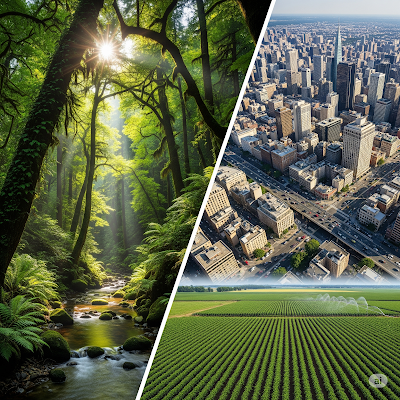🌿 Which is Not a Natural Ecosystem
? | Explained with Examples & FAQs
📝 Introduction: Why it matters?
Have you ever wondered what actually counts as a natural ecosystem, and what doesn’t?
It’s a common question among students preparing for competitive exams, and even for general understanding of our environment.
Knowing the difference is crucial, not just for exam scores but also to appreciate how nature and humans interact.
In this article, we’ll clearly explain:
✅ What is a natural ecosystem?
✅ What is not a natural ecosystem?
✅ Examples, FAQs, and a simple conclusion.
🌱 What is a Natural Ecosystem?
A natural ecosystem is a community of living and non-living things that interact with each other without direct human involvement.
It is self-sustaining and evolves naturally over time.
🔍 Key characteristics:
-
Self-regulated: No human interference required for maintenance.
-
Balanced: Plants, animals, microorganisms, soil, water, and air all maintain natural balance.
-
Dynamic: Changes happen on their own (like seasons, migrations, succession).
🌿 Examples of Natural Ecosystems
Let’s look at some real-world examples of natural ecosystems:
✅ Forests:
From dense tropical rainforests in Kerala to pine forests in Himachal, these are perfect examples where trees, animals, birds, insects and soil microbes live together without external management.
✅ Rivers & Lakes:
Natural water bodies have their own fish, aquatic plants, amphibians, bacteria and even specific water chemistry.
✅ Deserts:
Despite harsh conditions, deserts like the Thar in India are home to cacti, camels, reptiles, and unique insects.
✅ Oceans:
The vast marine ecosystem includes corals, whales, sharks, plankton, algae, and countless species.
✅ Grasslands:
Savannas in Africa or grass plains of North India where herbivores graze and predators hunt, all under natural cycles.
🏗️ What is NOT a Natural Ecosystem?
A non-natural ecosystem (artificial ecosystem) is an area or system that exists or is maintained due to direct human planning, intervention, and management.
These do not occur on their own.
🔍 Characteristics:
-
Created or heavily modified by humans.
-
Require human maintenance (cleaning, feeding, watering, pesticide use etc).
-
Often designed for human benefits (food, aesthetics, profit).
🚫 Examples of Non-Natural Ecosystems (Artificial Ecosystems)
✅ Crop fields / Farmlands:
Rice paddies, wheat fields, sugarcane plantations — all are artificial ecosystems managed by humans for food production. They rely on fertilizers, irrigation and human care.
✅ Aquariums:
Tiny water bodies set up inside glass tanks for ornamental fish. Without daily feeding and cleaning, fish would not survive.
✅ Botanical gardens:
Carefully landscaped and curated with exotic plants, watered and trimmed by gardeners.
✅ Zoos:
Animals are kept inside enclosures, artificially fed and treated for diseases.
✅ Urban parks & lawns:
Though green, these need regular mowing, watering, pest control — not self-sustaining.
🌍 Why is this distinction important?
Understanding what is not a natural ecosystem helps us realize how much human intervention changes nature.
-
In natural ecosystems, biodiversity maintains itself.
-
In artificial ecosystems, humans must constantly manage balance, else it collapses.
This is why conserving natural ecosystems is so vital for the planet’s long-term health.
🔬 Difference between Natural and Artificial Ecosystems (Quick Table)
| Feature | Natural Ecosystem | Artificial Ecosystem |
|---|---|---|
| Created by? | Nature | Humans |
| Maintains by? | Self-regulated processes | Requires human care |
| Examples | Forests, oceans, lakes | Farmlands, aquariums, zoos |
| Biodiversity | Very high | Generally low or controlled |
| Sustainability | Naturally balanced | Dependent on human actions |
🤔 FAQs
❓ Which of the following is not a natural ecosystem?
Options like:
-
Aquarium
-
Pond
-
Forest
-
Ocean
👉 The answer is: Aquarium
Because it is artificially built and maintained by humans.
❓ Are crop fields a natural ecosystem?
No. Crop fields are artificial ecosystems. They are designed by humans, planted, irrigated, sprayed with fertilizers and pesticides, and harvested.
❓ Why are forests considered natural ecosystems?
Forests form naturally, sustain various plant & animal species without external help, and evolve over hundreds of years through natural processes like succession.
❓ Are urban parks natural?
No. Parks inside cities are artificial green spaces created and maintained by humans.
📝 Conclusion: Key Takeaway
-
Natural ecosystems like forests, rivers, oceans, deserts exist on their own and are balanced by natural processes.
-
Artificial ecosystems like aquariums, farmlands, zoos are created and maintained by humans.
-
Knowing this helps us understand the importance of protecting natural habitats and minimizing unnecessary human interference.










.jpeg)











.jpg)


0 #type=(blogger):
Post a Comment